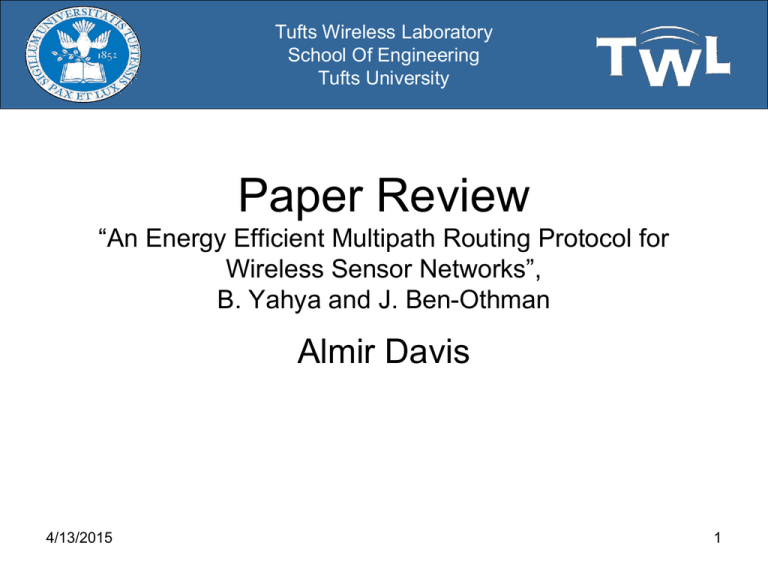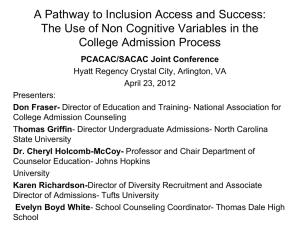Presentation 05 - Tufts Wireless Laboratory
advertisement

Tufts Wireless Laboratory School Of Engineering Tufts University Paper Review “An Energy Efficient Multipath Routing Protocol for Wireless Sensor Networks”, B. Yahya and J. Ben-Othman Almir Davis 4/13/2015 1 Tufts Wireless Laboratory School Of Engineering Tufts University Key Findings • • • • One of the best papers I have read so far in WSN arena Very clear organization A lot of information about already available architectures Paper proposes a unique, innovative approach to solve power problem in WSN (called EMR1 and EMR2) • A lot of testing and performance benchmarking included to back the theory 4/13/2015 2 Tufts Wireless Laboratory School Of Engineering Tufts University Why traditional routing cannot be implemented in WSNs? (1) • routing protocols cannot be applied to sensor networks, where building a global addressing scheme is necessary for such protocols to work, which is not feasible in large scale deployments of sensor networks • in many applications of sensor networks, the flow of the sensed data should be from different sources to a single target (sink node) • sensor nodes are tightly constrained in terms of battery power, processing power, and storage capacity, and hence a careful resources management is required. 4/13/2015 3 Tufts Wireless Laboratory School Of Engineering Tufts University Routing Techniques Classification • • • • negotiation based query based QoS based multipath based (this paper is based on this technique) 4/13/2015 4 Tufts Wireless Laboratory School Of Engineering Tufts University EMR (Efficient Multipath Routing) • EMR uses the residual energy, node available buffer size, and Signal-to-Noise Ratio (SNR) to predict the next hop through the path construction phase • Two EMR Protocols: – EMR-1 – EMR-2 4/13/2015 5 Tufts Wireless Laboratory School Of Engineering Tufts University EMR-1 • EMR-1: uses a single path among the discovered paths to transfer the whole data message, when this path cost falls bellow a certain threshold, it then switches to the next alternative path. 4/13/2015 6 Tufts Wireless Laboratory School Of Engineering Tufts University EMR-2 • EMR-2: adds data redundancy to the original data message and uses multiple paths to transmit the data 4/13/2015 7 Tufts Wireless Laboratory School Of Engineering Tufts University Related Work (1) • Sequential Assignment Routing (SAR) protocol - SAR protocol is a multi-path routing protocol that makes routing decisions based on three factors: energy resources, Quality of Service (QoS) on each path, and packet’s priority level (increases fault tolerance but suffers from overhead of maintaining tables) • Chang and L. Tassiulas have proposed a multipath routing protocol (nodes in the first path will not completely drain their energy through continual use of the same path, hence achieving longer lifetime. Here, the path switching cost is an incremental overhead. ) 4/13/2015 8 Tufts Wireless Laboratory School Of Engineering Tufts University Related Work (2) • Directed Diffusion Paradigm: the source node or an intermediate node selects one path from the available multiple paths to delivery the data to sink, based on the quality of data delivery (e.g. delay, throughput). Based on the changes on the network conditions, a node may change its primary path to another one (limited by the inherent delay of such scheme to switch to and establish a new primary path in case of network error conditions. As well, in case of path failure, the protocol lacks of an efficient retransmission control mechanism which depletes quickly the node energy resources) 4/13/2015 9 Tufts Wireless Laboratory School Of Engineering Tufts University Description of EMR Protocol (1) • Assumptions: – sensor nodes are distributed randomly in the sensing field – All nodes have the same transmission range – enough battery power to carry their sensing, computing, and communication activities – Network is fully connected and dense – Additionally, at any time, we assume that each – sensor node is able to compute its residual energy, and its available buffer size, as well as record the link performance between itself and its neighboring node in terms of signal-to-noise ratio (SNR). 4/13/2015 10 Tufts Wireless Laboratory School Of Engineering Tufts University Description of EMR Protocol (2) • Link Cost Function: – Cost function includes an energy factor, available buffer factor, and interference factor with appropriate weights (α, β, and γ): 4/13/2015 11 Tufts Wireless Laboratory School Of Engineering Tufts University Description of EMR Protocol (3) • Discovery Procedure: – Initialization phase – Primary Path discovery phase – Alternative Paths discover phase • Path Maintenance • Traffic allocation and data transmission – Transfer through Single-path at a time – Transfer data across multiple paths simultaneously 4/13/2015 • Paths Selection • Message Segmentation • Message Forwarding and Recovery 12 Tufts Wireless Laboratory School Of Engineering Tufts University EMR Performance Evaluation • Assumptions: – NS-2 Simulation environment – Comparison made against N-to-1 multipath routing protocol and Directed Diffusion – Field 500mx500m – Node radio transmission range set to 25m – Performance matrix: Average Energy Consumption, Delivery Ration, and Delay 4/13/2015 13 Tufts Wireless Laboratory School Of Engineering Tufts University EMR Performance Evaluation • Average Energy Consumption: 4/13/2015 14 Tufts Wireless Laboratory School Of Engineering Tufts University EMR Performance Evaluation • Delivery Ratio: 4/13/2015 15 Tufts Wireless Laboratory School Of Engineering Tufts University EMR Performance Evaluation • Delay: 4/13/2015 16 Tufts Wireless Laboratory School Of Engineering Tufts University EMR Performance Evaluation • Average Energy Consumption: 4/13/2015 17 Tufts Wireless Laboratory School Of Engineering Tufts University EMR Performance Evaluation • Delivery Ratio: 4/13/2015 18 Tufts Wireless Laboratory School Of Engineering Tufts University EMR Performance Evaluation • Delay: 4/13/2015 19







